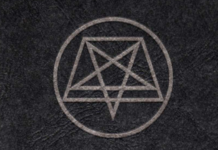
Far too long has the subject of Satanic magic and philosophy been written down by wild-eyed journalists of the right-hand path.
–Anton Szandor LaVey, The Satanic Bible ((Anton LaVey, The Satanic Bible (New York: Avon, 1969), 21.))
While not a “wild-eyed journalist of the right-hand path” (whether defined in tantric, Blavatskian, or New Age terms), I have, over the past few months, shared some rather amusing sensationalist news stories written by those who are.1 I thought it only fair to take the time to write a short piece on Satanism as it’s actually practiced today, and go beyond highlighting some of the more absurd stories that rise out of the deep.
This is a little tricky, as Satanism is a broad term these days that now encompasses a variety of religions. There’s traditional Satanism, which does involve devil-worship; and Luciferianism, which (sometimes) runs along similar veins. However, there’s also modern and LaVeyan Satanism, which does not, as these Satanists are atheistic, holding the self in the highest position of reverence.
Related: Satanic Mythos: A brief study of four infernal archetypes, by Noktvs Infernvs
Related: The foundations of Satanic belief, by Jashan A’al
Related: Traditional Satanism, by Jashan A’al
Related: Modern Satanism, by Jashan A’al
Related: Luciferianism, by Jashan A’al
For years I managed the website for the Satanic e-list EvilOne.org (now defunct) — a great bunch who inspired a fondness for all things Satanic in my (cold, black) heart.2 The list was primarily inspired by LaVeyan and modern Satanism, though not affiliated with any specific organization, and that’s what we’ll look at today.
Anton Szandor LaVey (born Howard Stanton Levey, 1930-1997) was the first to formulate an organized Satanic religion. For LaVey, Satan represented a force of nature:
…the powers of darkness which have been named for just that because no religion has taken the forces out of the darkness. Nor has science been able to apply technical terminology to this force. It is an untapped reservoir that few can make use of because they lack the ability to use a tool without having to first break down and label all the parts which make it run. It is this incessant need to analyze which prohibits most people from taking advantage of this many faceted key to the unknown — which the Satanist chooses to call “Satan.”3
Related: Satanism in music and devotional practice, by Marie RavenSoul
Related: Satanic art: A devotional practice, by Marie RavenSoul
The ironically named Church of Satan (or the Satanic Church, as it was initially titled) was officially created on 30 April 1966, though born out of an earlier lecture group, the Magic Circle. It was a church without gods that encouraged reservation of belief:
It has been said that “the truth will make men free.” The truth alone has never set anyone free. It is only DOUBT which will bring mental emancipation. Without the wonderful element of doubt, the doorway through which truth passes would be tightly shut, impervious to the most strenuous poundings of a thousand Lucifers.4
The Church he established is still active today, and for a mere two hundred dollars American (sorry Canadians, it was a better deal a few months ago. Don’t worry, the it’ll go down again!) and a signed statement affirming one’s intention to join, becoming a card carrying member of the Church of Satan is quite simple.
Related: Iconic occult documentaries of the ’70s, by Jenna Danchuk
In 1969 LaVey released The Satanic Bible, the defining text of what has come to be known as LaVeyan Satanism, and this book subsequently inspired many of its derivatives. The Satanic Bible clearly laid out the tenets, rites and rituals of Satanism for the first time written by and for self-proclaimed Satanists.
Philosophically, LaVey was strongly influenced by the will to power of Friedrich Nietzsche and the Objectivism of Ayn Rand, layered with a ritual magick predominately derived from Aleister Crowley. LaVey advocated a “controlled selfishness,” tempered with a straightforward approach to personal conduct, promoting “responsibility to the responsible.”
LaVey writes:
“Satanism is based on a very sound philosophy,” say the emancipated. “But why call it Satanism? Why not call it something like ‘Humanism’ or a name that would have the connotation of a witchcraft group, something a little more esoteric — something less blatant.” There is more than one reason for this. Humanism is not a religion. It is simply a way of life with no ceremony or dogma. Satanism has both ceremony and dogma.5
Indeed, in general the philosophy is quite sensible and morally upstanding from a rational standpoint. Pointing out that LaVey wrote specifically against ritual murder, animal sacrifice and torture may seem superfluous, but it’s quite surprising to discover how many intelligent and otherwise well informed people seem to have this misguided estimation of Satanic practice.
For more information on LaVeyan and modern Satanism, see The Satanic Bible and the various works by Anton LaVey, as well as The Satanic Scriptures
by Peter Gilmore, the current High Priest of the Church of Satan, and the Church of Satan’s website.
Related: The Satanic Scriptures, reviewed by Psyche
Related: Meditations on the Satanic Statements, reviewed by Saros
First published on Plutonica.net, “A note on LaVeyan Satanism,” on 22 January 2008.
- Posts published in the now-defunct blog, Plutonica.net: “News: Catholic Pope orders bishops to set up “exorcism squads,”” “News: Residents of Reeves, Louisiana finally “escape” the 666 area code,” “News: Satanic hand severed, microwaved and a plane-flying rat brain,” and “News: Motion 666 calls for the disestablishment of the Church of England,” to start. [↩]
- However, I don’t currently have any Satanic affiliations. [↩]
- p. 62 [↩]
- p. 39 [↩]
- p. 50. [↩]








